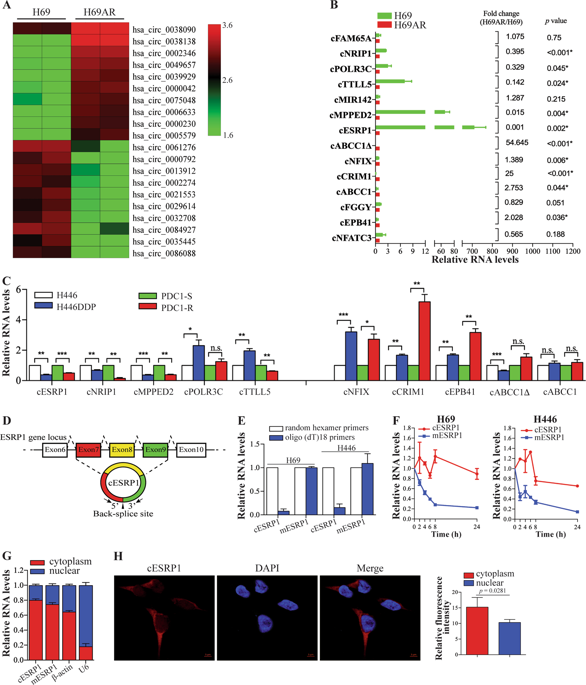当前位置:
X-MOL 学术
›
Cell Death Differ.
›
论文详情
Our official English website, www.x-mol.net, welcomes your
feedback! (Note: you will need to create a separate account there.)
Circular RNA cESRP1 sensitises small cell lung cancer cells to chemotherapy by sponging miR-93-5p to inhibit TGF-β signalling.
Cell Death and Differentiation ( IF 13.7 ) Pub Date : 2019-11-14 , DOI: 10.1038/s41418-019-0455-x Weimei Huang 1 , Yunchu Yang 1 , Jingfang Wu 1 , Yuchun Niu 1, 2 , Yao Yao 3 , Jian Zhang 4 , Xiaoxian Huang 5 , Shumei Liang 1 , Rui Chen 1 , Size Chen 6 , Linlang Guo 1
Cell Death and Differentiation ( IF 13.7 ) Pub Date : 2019-11-14 , DOI: 10.1038/s41418-019-0455-x Weimei Huang 1 , Yunchu Yang 1 , Jingfang Wu 1 , Yuchun Niu 1, 2 , Yao Yao 3 , Jian Zhang 4 , Xiaoxian Huang 5 , Shumei Liang 1 , Rui Chen 1 , Size Chen 6 , Linlang Guo 1
Affiliation

|
Circular RNAs (circRNAs) are novel RNA molecules that play important roles in chemoresistance in different cancers, including breast and gastric cancers. However, whether circRNAs are involved in the response to chemotherapy in small cell lung cancer (SCLC) remains largely unknown. In this study, we observed that cESRP1 (circular RNA epithelial splicing regulatory protein-1) expression was significantly downregulated in the chemoresistant cells compared with the parental chemosensitive cells. cESRP1 enhanced drug sensitivity by repressing miR-93-5p in SCLC. Cytoplasmic cESRP1 could directly bind to miR-93-5p and inhibit the posttranscriptional repression mediated by miR-93-5p, thereby upregulating the expression of the miR-93-5p downstream targets Smad7/p21(CDKN1A) and forming a negative feedback loop to regulate transforming growth factor-β (TGF-β) mediated epithelial-mesenchymal transition. Furthermore, cESRP1 overexpression and TGF-β pathway inhibition both altered tumour responsiveness to chemotherapy in an acquired chemoresistant patient-derived xenograft model. Importantly, cESRP1 expression was downregulated in SCLC patient tissues and was associated with survival. Our findings reveal, for the first time, that cESRP1 plays crucial a role in SCLC chemosensitivity by sponging miR-93-5p to inhibit the TGF-β pathway, suggesting that cESRP1 may serve as a valuable prognostic biomarker and a potential therapeutic target in SCLC patients.
中文翻译:

环状 RNA cESRP1 通过海绵状 miR-93-5p 抑制 TGF-β 信号传导,使小细胞肺癌细胞对化疗敏感。
环状 RNA (circRNA) 是新型 RNA 分子,在不同癌症(包括乳腺癌和胃癌)的化学抗性中起重要作用。然而,circRNAs 是否参与了小细胞肺癌 (SCLC) 对化疗的反应仍然很大程度上未知。在这项研究中,我们观察到与亲本化学敏感细胞相比,化学抗性细胞中 cESRP1(环状 RNA 上皮剪接调节蛋白-1)的表达显着下调。cESRP1 通过抑制 SCLC 中的 miR-93-5p 来增强药物敏感性。细胞质 cESRP1 可直接与 miR-93-5p 结合,抑制 miR-93-5p 介导的转录后抑制,从而上调 miR-93-5p 下游靶标 Smad7/p21(CDKN1A) 的表达并形成负反馈环来调节转化生长因子-β (TGF-β) 介导的上皮间质转化。此外,在获得性化疗耐药患者衍生的异种移植模型中,cESRP1 过表达和 TGF-β 通路抑制都改变了肿瘤对化疗的反应。重要的是,cESRP1 表达在 SCLC 患者组织中下调,并与存活率相关。我们的研究结果首次揭示了 cESRP1 通过海绵 miR-93-5p 抑制 TGF-β 通路在 SCLC 化学敏感性中发挥关键作用,这表明 cESRP1 可能作为一种有价值的预后生物标志物和 SCLC 的潜在治疗靶点耐心。在获得性化疗耐药患者衍生的异种移植模型中,cESRP1 过表达和 TGF-β 通路抑制都改变了肿瘤对化疗的反应。重要的是,cESRP1 表达在 SCLC 患者组织中下调,并与存活率相关。我们的研究结果首次揭示了 cESRP1 通过海绵 miR-93-5p 抑制 TGF-β 通路在 SCLC 化学敏感性中发挥关键作用,这表明 cESRP1 可能作为一种有价值的预后生物标志物和 SCLC 的潜在治疗靶点耐心。在获得性化疗耐药患者衍生的异种移植模型中,cESRP1 过表达和 TGF-β 通路抑制都改变了肿瘤对化疗的反应。重要的是,cESRP1 表达在 SCLC 患者组织中下调,并与存活率相关。我们的研究结果首次揭示了 cESRP1 通过海绵 miR-93-5p 抑制 TGF-β 通路在 SCLC 化学敏感性中发挥关键作用,这表明 cESRP1 可能作为一种有价值的预后生物标志物和 SCLC 的潜在治疗靶点耐心。
更新日期:2019-11-14
中文翻译:

环状 RNA cESRP1 通过海绵状 miR-93-5p 抑制 TGF-β 信号传导,使小细胞肺癌细胞对化疗敏感。
环状 RNA (circRNA) 是新型 RNA 分子,在不同癌症(包括乳腺癌和胃癌)的化学抗性中起重要作用。然而,circRNAs 是否参与了小细胞肺癌 (SCLC) 对化疗的反应仍然很大程度上未知。在这项研究中,我们观察到与亲本化学敏感细胞相比,化学抗性细胞中 cESRP1(环状 RNA 上皮剪接调节蛋白-1)的表达显着下调。cESRP1 通过抑制 SCLC 中的 miR-93-5p 来增强药物敏感性。细胞质 cESRP1 可直接与 miR-93-5p 结合,抑制 miR-93-5p 介导的转录后抑制,从而上调 miR-93-5p 下游靶标 Smad7/p21(CDKN1A) 的表达并形成负反馈环来调节转化生长因子-β (TGF-β) 介导的上皮间质转化。此外,在获得性化疗耐药患者衍生的异种移植模型中,cESRP1 过表达和 TGF-β 通路抑制都改变了肿瘤对化疗的反应。重要的是,cESRP1 表达在 SCLC 患者组织中下调,并与存活率相关。我们的研究结果首次揭示了 cESRP1 通过海绵 miR-93-5p 抑制 TGF-β 通路在 SCLC 化学敏感性中发挥关键作用,这表明 cESRP1 可能作为一种有价值的预后生物标志物和 SCLC 的潜在治疗靶点耐心。在获得性化疗耐药患者衍生的异种移植模型中,cESRP1 过表达和 TGF-β 通路抑制都改变了肿瘤对化疗的反应。重要的是,cESRP1 表达在 SCLC 患者组织中下调,并与存活率相关。我们的研究结果首次揭示了 cESRP1 通过海绵 miR-93-5p 抑制 TGF-β 通路在 SCLC 化学敏感性中发挥关键作用,这表明 cESRP1 可能作为一种有价值的预后生物标志物和 SCLC 的潜在治疗靶点耐心。在获得性化疗耐药患者衍生的异种移植模型中,cESRP1 过表达和 TGF-β 通路抑制都改变了肿瘤对化疗的反应。重要的是,cESRP1 表达在 SCLC 患者组织中下调,并与存活率相关。我们的研究结果首次揭示了 cESRP1 通过海绵 miR-93-5p 抑制 TGF-β 通路在 SCLC 化学敏感性中发挥关键作用,这表明 cESRP1 可能作为一种有价值的预后生物标志物和 SCLC 的潜在治疗靶点耐心。









































 京公网安备 11010802027423号
京公网安备 11010802027423号